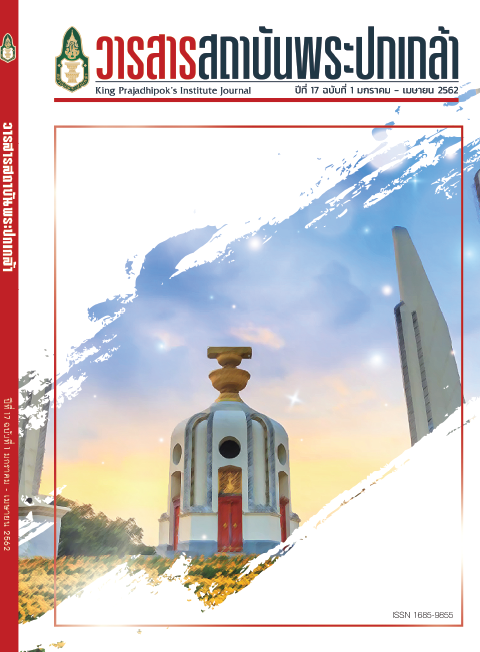Public Policies for Reducing Inequality in Thailand : Microfinance
Main Article Content
Abstract
Inequality may derive from lack of opportunities, rights, and natural resources,although to some people, it must have been caused by bad luck or past-life sins. No matter the cause of inequality, the government should be held accountable for
reducing inequality in the society. Sarinee Achavanuntakul (2011:38) asserts that economic inequality, particularly income inequality, is the most recognized inequality of all. Although it is known that one way to tackle poverty and income
inequality issues is to provide more economic opportunities, i.e. “financialinclusion”, for grassroots people, certain groups of them surprisingly have difficulty accessing services of financial institutions.
Muhammad Yunus, who was jointly awarded the 2006 Nobel Peace Prize together with the Grameen Bank, initiated a theory-based view stating that to develop human capital, loan serve as money which can create capital. This could make the people who receive loan facing the situation of poverty. Nonetheless, since access to the commercial financial system is complicated and credit borrowers have to own assets, those who have low income and do not own any assets are not usually granted credit for consumption and investment, hence are unable to free themselves from the vicious cycle of poverty. “Microfinance” may therefore be made available for low-income people. With regard to microfinance in Thailand, it is found that financial institutions have provided numerous types of financial services for poor and low-income people. However, despite the existence of the institutions, there are still limitations to the services provided. As a result, the
government sector should perform a role in reforming microfinance in Thailand as well as enforcing more practical policies. In particular, a Microfinance Act should be enacted and a committee established to be directly responsible so that corporate governance of the financial system works to solve inequality, stabilize the nation’s microfinance, and turn it to be a “social safety net”, and eventually reclaim “human dignity” for the low-income and poor people in Thailand.
Article Details
@ 2020 King Prajadhipok's Institute The Government Complex Commemorating All Right Reserved.
References
กระทรวงการคลัง. (2554). 50 ปี 50 บทความนำไทยก้าวไกล. กรุงเทพฯ: ม.ป.พ.
ทวีศักดิ์ มานะกุล. (2554). การพัฒนาระบบการเงินระดับฐานในประเทศไทย. ใน 50 ปี 50 บทความนำไทยก้าวไกล. เนื่องในโอกาสวันสถาปนาครบรอบ 50 ปี สำนักงานเศรษฐกิจการคลัง. กรุงเทพฯ: มปพ.
ธนาคารแห่งประเทศไทย. (2556). รายงานประจำปี 2556. กรุงเทพฯ: ธนาคารแห่งประเทศไทย.
ป๋วย อึ๊งภากรณ์., (2512). ศีลธรรมและศาสนาในการพัฒนาชาติ ใน ปาฐกถาอนุสรณ์ซินแคลร์ ทอมป์สัน ค.ศ. 1969. วิทยาลัยพระคริสตธรรมในประเทศไทย และสภาคริสตจักรในประเทศไทย 21-23 มกราคม 2512.
เปิดทางตั้งแบงก์ชุมชนทุกตำบลฝาก – กู้ได้. (2561). เดลินิวส์. สืบค้นจาก https://www.dailynews.co.th/economic/625839.
สถาบันวิจัยเพื่อการพัฒนาประเทศไทย. (2553). ความเหลื่อมล้ำที่จับต้องได้. [เว็บไซต์]. สืบค้นจาก http://tdri.or.th/tdri-insight/inequality-worawan/
สภาปฏิรูปแห่งชาติ. (2558). วาระปฏิรูปที่ 13 : การปฏิรูปการเงินฐานรากและสหกรณ์ออมทรัพย์ แนวทางการปฏิรูปการเงินฐานราก. กรุงเทพฯ : สำนักการพิมพ์สำนักงานเลขาธิการสภาผู้แทนราษฎร.
สมศักดิ์ อมรสิริพงศ์. (2558). การจัดการการคลัง. นครปฐม : หลักสูตรรัฐประศาสนศาสตร์บัณฑิต สาขาวิชานโยบายสาธารณะและการจัดการภาครัฐ ภาควิชาสังคมศาสตร์และมนุษยศาสตร์ มหาวิทยาลัยมหิดล.
สฤณี อาชวานันทกุล. (2554). ความเหลื่อมล้ำฉบับพกพา. นนทบุรี เปนไทพับบลิชชิ่ง.
สำนักงานเศรษฐกิจการคลัง. (2558). นวัตกรรมในการพัฒนาระบบการเงินภาคประชาชน : แผนที่การเข้าถึงบริการทางการเงินระดับฐานราก, ผลงานวิชาการเสนอในงานสัมมนาวิชาการประจำปีของสำนักงานเศรษฐกิจการคลัง “นวัตกรรมการคลังการเงินเพื่อการปฏิรูปประเทศไทย” วันพุธที่ 26 สิงหาคม 2558 ณ โรงแรมพลาซ่า แอทธินี รอยัล เมอริเดียน. สืบค้นจาก http://www.fpo.go.th/FPO/modules/Content/getfile.php?contentfileID=9570
Banerjee, Abhijit V. & Duflo, Esther, 2005. “Growth Theory through the Lens of Development Economics,” Handbook of Economic Growth, in: Philippe Aghion & Steven Durlauf (ed.), Handbook of Economic Growth, edition 1, volume 1, chapter 7, pages 473-552, Elsevier.
Beck T, Demirgüç-Kunt A and Levine R. (2000) A New database on the Structure and Development of the Financial Sector. The World Bank Economic Review, 14(3), pp. 597-605.
Khan MS. (1977). Variable expectation and the demand for money for money in high-inflation countries. The Manchester School; 45(3), pp. 270-93.
King RG and Levine R. (1993). Finance, entrepreneurship and growth. Journal of Monetary economics, 32(3), pp. 513-42.
Ladman, Jerry, and Tinnermeier, Ronald. (1981). The Political Economy of Agricultural Credit: The Case of Bolivi. American journal of agricultural economics, (63)1, pp. 66-72.
Porta RL, Lopez-de-Silanes F, Shleifer A and Vishny RW. (1998). Law and finance. Journal of political economy, 106(6), pp. 1113-55.
World Bank. (2007). World development report 2008: Agriculture for development. Washington, DC. : World Bank.
Yaron J, Benjamin M and Charitonenko S. (1998). Promoting efficient rural financial intermediation. The World Bank Research Observer, 13(2), pp. 147-70.

